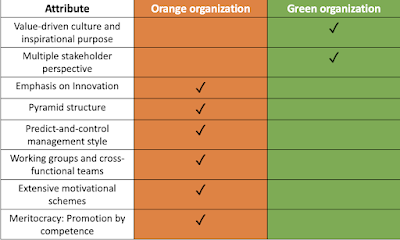The Challenge of Multi-color Organizational Management
Seeking the source of consulting challenges.
As a procurement consultant, I'm increasingly exposed to the IT software development industry.
In my latest consulting endeavors, I have realized that my traditional views, actionable advice, and best-practice tools aren't working efficiently enough. (I believe) it's not because I'm orthodox - my background and skills are diverse enough to offer variable solutions.
I classified the nature of my consulting challenges as "multi-color organizational management."
New organizations for the VUCA world
Frederic Laloux, in his book "Reinventing Organizations," suggested the concept of organizational development suited for the VUCA world.
As per Laloux, the right level of organizational development links to the collective consciousness of its members, especially top management.
- Amber (formal roles within a hierarchical pyramid, top-down command-and-control)
- Orange (management by objectives, innovation, accountability, and meritocracy)
- Green (culture and empowerment, stakeholder model)
- Teal (self-management, wholeness, evolutionary purpose.)
Apparently, I wrote about some of these virtues, e.g., leadership. I only branded it Agile values, a broader concept spreading beyond organizational science.
Reality check of organizational management models
When I looked at Laloux's definitions of each organizational model, I could see my client IT companies primarily transitioning from Orange to Green.
Let's see.
As Green organizations, they exercise a value-driven culture and respect multiple stakeholder perspectives. The majority of their decisions are based on consensus.
Yet, they still demonstrate typical Orange virtues: innovation emphasis, pyramid structure with a high centralization, active engagement of working groups and cross-functional teams, extensive motivational efforts, and meritocratic career development.
Moreover, shareholders want these companies to become Teal. It's ambitious, contemporary, and endorsed - just like being a Unicorn.
Three crucial challenges of the multi-color organizational management
This multi-colored environment creates particular practical challenges.
While Orange companies reside on traditional hierarchies and formal processes, Greens promote democracy and consensus decision-making.
Many IT companies don't have a long evolutionary path behind them - in 10-20 years of their existence, they hardly established themselves as true Orange. Their governance is holey, and the primary discipline of cornerstone processes barely exists.
My experience suggests that injecting Green values into such companies makes it nearly impossible to conduct efficient procurement transformation.
Process compliance demotivates creative colleagues, and every operational enhancement is unpopular and cannot produce a consensus. People in different functions randomly feel the empowerment to do procurement - but only its fun parts related to the very process of buying, not documents, routines, or contractual obligations.
The individual and organizational transformation must be sequential.
The first and most crucial point reconfirmed by nearly all sources I turned to is "it is impossible to skip stages."
Each stage corresponds to the current level of consciousness and a form of organization. Essential managing and contributing stakeholders must be Green to build a genuinely Green company.
What I'm seeing is, in fact, Orange executives promoting Green values.
At the same time, Green employees (indeed, this level is way more comfortable for individuals) disregard the remains of Orange artifacts without mastering them and evolving ahead.
Secondly, it all starts with personal development.
Orange managers don't want to let go of the associated power and authority, while some employees haven't even developed to the Orange level but naturally prefer Green virtues.
Finally, the way to the top of Laloux's pyramid of consciousness assumes an increased level of trust. Meanwhile, many self-declared Green and even Teal people don't trust others.
Reality check and emotional openness
We must reflect on our actual and declared fundamental values and emotional openness.We should establish a professional basis and maturity level and then evolve gradually and mindfully.
The most difficult will be to overcome the temptation of cherry-picking fun parts of each organizational model and disregard the "boring" ones.
Writing this, I feel like a killjoy. Perhaps, that's what I am - an Amber anachronist in the Green party.
P.S. If you appreciate hundreds of hours invested in researching and writing this blog, you can buy me a coffee or subscribe for the membership by following this link. Thank you!
More information on this and other exciting topics can be found in "The Technology Procurement Handbook." It represents 23 years of experience, billions of dollars worth of successful sourcing projects, and 1000s of hours spent on research, analysis, and content creation for the most demanding professional readers.







Comments
Post a Comment